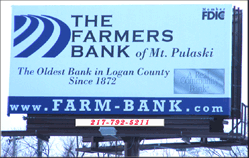 Steve Bracey, resource conservationist, and Bill Dickerson, district
conservationist, of the Logan County Soil and Water Conservation
District in Lincoln, call this group the Logan County innovators of
no-till farming. Steve Bracey, resource conservationist, and Bill Dickerson, district
conservationist, of the Logan County Soil and Water Conservation
District in Lincoln, call this group the Logan County innovators of
no-till farming.
So it should come as no surprise that when the Land of Lincoln
Soil Savers Club recently met for breakfast, several of the members
reported they are using nontraditional cover crops on their no-till
acres.
More specifically, several of the no-tillers said that they were
incorporating radishes into their cover along with ryegrasses.
When looking at cover crops in Logan County, there are both
positives and negatives in their use. The most apparent positives
are that they protect the soil surface, increase soil organic matter
and reduce erosion. In addition, cover crops can help extract
residual nitrates and sequester carbon.
On the negative side, first and foremost may be the added cost.

Another consideration in using a cover crop is that it is a
double-edged sword. In some years, ground cover may help hold
moisture in soil. But in a dry year such as 2012, those same cover
crops can steal moisture from the soil, thus hindering cash crop
production.
Dan Towery of the Conservation Cropping Systems Initiative
was the guest speaker at the recent Soil Savers meeting. Towery
noted there is another, more or less self-imposed negative to using
cover crops: the planting dates.
For cover crops such as turnips or radishes to have enough time
to establish prior to winter kill-down, they must be planted between
July 15 and Sept. 15, the heart of the growing season for corn.
Cereal ryes, which are also excellent cover crops, can be planted
later: between late August and early November.
Towery said that many farmers have a mental block with planting a
crop in a growing crop. But in addition, the method of seeding
causes some issues as well. For the most part, there aren't many
farm tools available that can do this job with corn that is 3 feet
or more tall. Then, aerial application is the easiest and best
answer.
Towery also told the group that the most effective usage of
radish would be as part of a mix with another cover crop. He said
that he would encourage a mix of radish with either oats or cereal
rye and recommended 4 to 5 pounds of radish to 30 pounds of oats or
rye per acre. The cost would range from $15 to $30 per acre.
In contrast, Towery showed the group situations where no-till is
incorporated with organic farming, and the use of these same cover
crops greatly increased yields over a period of time.

He gave as an example what happened when three different cover
crop combinations were used on a no-till farm averaging 107 bushels
per acre on corn tests:
-
Using cereal rye, the corn harvest increased to 126
bushels.
-
With a combination of oats, rye and turnip, the yield
jumped to 164 bushels.
-
The final combination of winter peas and radishes brought
the yields up to 169 bushels per acre on the corn crop.
With current corn prices at $7.20 to $7.30 a bushel, this would
increase revenues of $130 per acre to over $400.
In a year like 2012, residue on the ground would have helped
retain moisture and provided a benefit at the onset of a drought
season. On the other hand, as the summer progressed with no water,
having that cover crop steal what little water there was would have
hurt the production crop.
With many farmers finding themselves "mudding" their crops in or
out after a couple of wet years, planting a soil-busting cover such
as radishes or turnips would have helped with compaction issues
through added aeration to the soil, increased microbial action and
the introduction of a greater earthworm population.
In addition, for those who needed to graze their animals on the
cover, turnips and radishes are a good alternative to grasses.
Towery told the group that if grazing is part of the plan, cattle
prefer turnips to radishes.
On the other hand, Towery said the tuber crops can also be
attractive to cutworms. Having those pests in the field could
eventually lead to them feasting on corn instead of radishes.
[to top of second column] |

Towery showed the group slides of root depths with radishes.
While the body of the radish was lean and only about 6 to 8 inches
long, the taproot and hair roots on the tuber were extremely long.
This results in the soil being broken up, with more organic matter
left behind. Towery also showed that researchers had dug up plots of
corn with radishes to see where the corn roots where going. They
found taproots from the cornstalks going as deep as 70 inches.
These same crops also help increase earthworm activity, further
increasing soil organic matter, aeration and reducing compaction.
Studies show that earthworms are attracted to the radishes and enjoy
eating through the heart of the tuber. The most desirable earthworm
is the one that travels horizontally through the upper layers of the
soil, consuming plant and soil matter and depositing fecal mater.
On the downside, there is something about radishes that stinks,
literally. Towery said the decayed radish lets off an offensive odor
similar to that of rotten cabbage. Because of this, radishes planted
near homesteads may cause some issues for those living there.
After the meeting, Towery spoke one-on-one with LDN about a
couple of cash cover crops. He said that in this area, wheat is not
being considered for a couple of reasons. The money isn't there to
make it worth the planting and harvest expense. He noted that in
this region as opposed to more southerly regions, the growing season
is a little too tight. For example, prime planting dates in Logan
County are mid-August to mid-October, while in Perry County,
approximately 170 miles due south, the planting season is Sept. 1 to
Nov. 1 for winter wheat.

Another cash cover crop trying to make its way into the Midwest
is pennycress. This oilseed crop is being marketed as a
non-food-competitive alternative for biodiesel and aviation jet
fuels.
Towery said pennycress will someday be a viable alternative for
Midwest farmers, but he doesn't think it is here yet. He referred to
it as still in its experimental stages, but said it shows promise.
Pennycress is planted in September, will overwinter and is
harvested in late spring. It produces a small, deep reddish-brown
seed that has 36 percent oil content. Soybeans, in comparison, have
only 18 percent oil content.
Towery said that right now one of the biggest stumbling blocks
the product is facing is yield. He said test plots have shown a
yield of 700 pounds per acre, but in less controlled environments,
the yields aren't there, not even close. He said he felt like the
company offering the product will overcome that problem, and
pennycress is something we may see more of in the future.
[By NILA SMITH]
Reference websites

|
Spring 2013
Logan County Farm Outlook
|
|